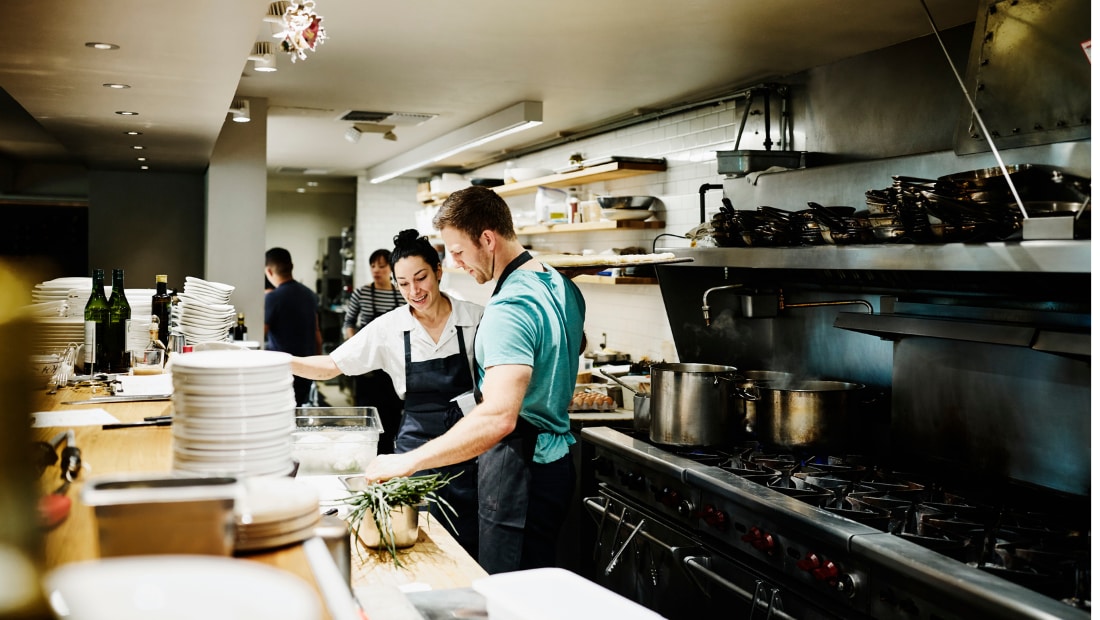The Next Level in Food Safety: From Simply Compliant to Total Commitment
Take your team to the next level of food safety by advancing from culture of compliance to a culture of commitment.

We all know the risks of a foodborne illness outbreak at a restaurant – the negative impact to the health and safety of diners, the lost productivity and a damaged reputation. As we close out Food Safety Month, I wanted to speak to what proactive steps we can take to motivate action, instill food safety best practices and prevent the harm that foodborne illnesses can cause.
Most people in the foodservice industry are familiar with food safety protocols from periodic trainings or onboarding new staff. But during a busy weekend night with a chaotic kitchen pressured to deliver food, these protocols can fall to the wayside. Especially with current industry challenges of job openings, high turnover and rising costs, it can be hard to prioritize food safety.
That’s why Ecolab and the National Restaurant Association sponsored a webinar on how to move from the food safety basics of training and awareness to motivating consistent action every day. We invited public health leaders from two organizations – Topgolf and Amtrak – to share how they help foster this culture of commitment.
Here are my top takeaways from our discussion.
Starting at the Top
A recent survey by the Association of Food and Drug Officials (AFDO) found that 31% of brands surveyed do not have shared accountability for food safety from the top management to food handlers. As Ann Marie McNamara, vice president for food safety and quality at US Foods, notes: “For food safety leaders to motivate and enact change, it starts at the top and moves down.”
Courtney Halbrook, Director of Environmental Health & Safety at Topgolf, and Bridget Sweet, Director of Public Health at Amtrak, both agreed that leadership must set the tone for a food safety culture and lead by example. Courtney and Bridget’s roles show how leadership should not only get involved but also help set expectations across an organization.
Leadership also plays a crucial role in each individual kitchen. Think about the difference that head chefs and kitchen managers can make when they follow food safety protocols themselves and encourage others to do so. Or, on the other hand, the negative impact they can have on a restaurant when they demonstrate that they don’t prioritize food safety, or it only matters when the health inspector is coming.

“You can have the best documented food safety processes and standards in the world, but if they’re not consistently put into practice by people, they’re useless.”
— Frank Yiannas
Deputy Commissioner of Food Policy and Response, U.S. Food and Drug Administration (FDA)
Powered by People
Frank Yiannas, deputy commissioner of food policy and response at the U.S. Food and Drug Administration (FDA), once said that “You can have the best documented food safety processes and standards in the world, but if they’re not consistently put into practice by people, they’re useless.” Your top resource for consistently serving safe food is the people behind it. That’s why training plays such a key role in food safety.
But how do we create training that motivates and is not simply a one-and-done approach? For information to stick, employees need to understand each task and associated risk and explain the “why”. Coaching also plays a key role so that employees are constantly given feedback, encouraged to ask questions and demonstrated proper protocol. But it’s important to balance coaching with appreciation and acknowledgment of the work the employees are doing. Bridget Sweet put it succinctly when she said, “ultimately, coaching should be a learning experience, not a fearful one.”
As an added bonus, training can help with employee retention, which has always been a challenge in the high turnover foodservice industry but has been especially painful in recent years. According to QSR Magazine, the biggest difference between employees likely to quit and those who will stay is the amount of training they receive.
Why Employee Motivation Matters
While training ensures employees know the right protocols, ensuring employees always act on those protocols can be difficult. There are a number of ways to encourage employees to get active and involved in food safety in their daily tasks.
Courtney Halbrook shared that Topgolf has a food safety employee recognition program for teams that work in their kitchens and ace a quarterly audit. An award is presented to the top location, framed and displayed in the kitchen as a reminder of their excellence in food safety.
At Ecolab, we hosted a Food Safety Heroes Sweepstakes to recognize back of house employees during the month of September. Over 170 managers nominated employees who took ownership of food safety and encouraged others on the team to do the same. Ecolab will be giving out prizes valued up to $500 to 20 of these food safety heroes. Receiving this type of recognition for food safety can uplift the employee and motivate them to embrace a food safety culture.
Time to Commit to Food Safety
There are many reasons to develop a culture that has a total commitment to food safety. Following food safety protocols reduces the risk of foodborne illness for customers and helps a restaurant maintain a positive reputation. It can also potentially improve your revenue with increased customer loyalty and traffic. And in times like these, where there’s an ongoing labor shortage in the restaurant industry, a positive food safety culture can help build a sense of shared purpose and belonging among employees, reducing staff turnover.
For the full conversation on getting to the next level in food safety, watch the webinar.


